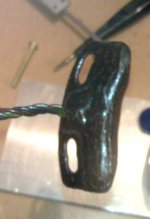dbaker said:
Excellent work, Toolman2! So we now have a benchmark for setting up the large HXT's. It looks like you used some perfboard to mount your Halls? In your opinion do we need to do the winding separation to use the HXT's with the 12 fet controllers?
Dave
yep it just the grid pattern board with single row traces.
i have the bike running now with 11.25: 1 gearing and 60v (loaded) pack, and a std 4310? 12 fet ecrazyman controller set at 35a limit.
-it goes well, about 52kph on a flat and it accelerates smoothly (with a bit of chain chatter) from a standing start, i cranked the current limit to about 50a
so theres about 3000w in, now it feels better and the motor is now getting warm to hot, and its toward the safe sustained maximum for this 12 fet controller.
so i put it along side the most efficient/torquey 6kg hub motored bike ive come across (and its also running 3000w in) and it won the 100meter uphill race (0 to 42kph odd) by 2 bike lengths, i had to drop the shunt (on the 80-100 130kV HXT motor) to about 2500w input and then they are both nearly equal!
in fact the average power used was 2565w for the hub motor and 2102w for the 80-100 to give identical acceleration and output for the run. the interesting difference is off the line where the hub motor pulls 3000w and (at under 5kph) over 2000w of this is going to heat, the 80-100 is different.. it only pulls about 1400w and i dont think any more than 500w is going to heat. -it (well the controller) off the line self limits to around 100a phase current because the motor resistance is so low, so it really cant (yet) press the motor into its inefficient zone.
-btw this self limiting (well below that of the actual set current) issue was a way bigger problem in delta, this helps tell us that you really do want the motor in star unless you have a 150a+ controller.
put simply the resistance is 8 times less than a "comparable" hub motor so off the line there's 8 times less heat (loss), anyway i spose im preaching to the converted here.. but its all looking good for a 1.3kg motor after its suprise win yesterday!
it would be good to hear from luke and others about how much real world continuous power these rc motors can take -my guess like any motor it may be able to do 3 times this (say 9kw) for a burst or running at light load and high rpm, but maby closer to 3kw in an ev that has massive start loads, long hills and not much cooling etc? let me know your thoughts people?




